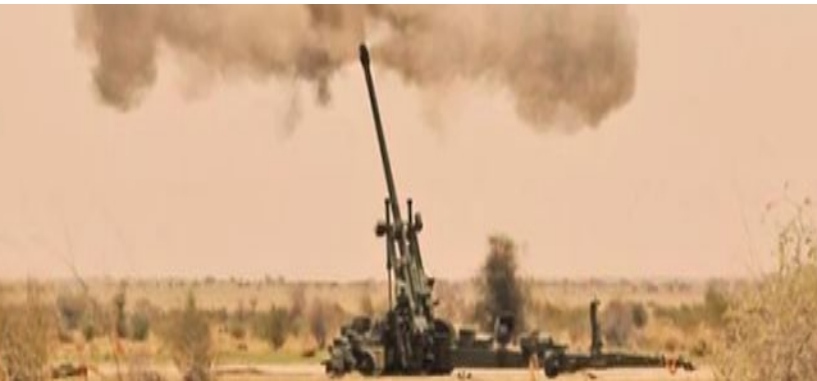Why L&T Is Offering The Indian Army A Homegrown Artillery Gun?

L&T- Nexter consortium’s ‘Trajan’ 152mm, howitzer during Indian Army firing trials at Pokhran
The army has a requirement of close to 3,000 artillery guns in various forms—towed, tracked, wheeled and mounted on high-mobility vehicles and ultra-light (air-droppable) howitzers. These numbers may even increase further.
In August 2020, the MoD placed towed artillery guns on a list of defence equipment it will not import after December 2021. The reasons being that after decades of import, howitzer manufacturing has taken an indigenous turn. Apart from the state-owned GCF, howitzer production lines exist in private sector Bharat Forge and Tata Advanced Systems in Bengaluru (both firms are making Advanced Towed Artillery Gun System or ATAGS prototypes).
The L&T offer could add a fourth gun assembly line. In February 2021, L&T supplied the 100th K9 Vajra self-propelled howitzer to the Indian army. It was part of a Rs 5,000 crore contract in 2017 in which the Indian firm partnered with South Korean defence major Hanwha Defence. These guns and the 145 M777 ultra-light howitzers being acquired from BAE Systems in 2015 are the army’s first new artillery purchases after it bought 410 Bofors guns in 1986.
The Indian army has urgent requirement for towed artillery guns. Larsen & Toubro Defence has now offered to supply 400 towed artillery gun systems, which the MoD earlier had no choice but to import from an Israeli firm. The L&T guns, jointly developed with French gun maker Nexter, can be made locally with an indigenous content of over 70 per cent. L&T is understood to have made the offer to the Indian army recently. The firm has said it can deliver the first gun in less than a year. The offer comes even as the bid to buy the Israeli guns has hit a dead end. Last month, the defence ministry overruled the purchase of 400 artillery guns from Israeli firm Elbit Systems because of OFB promise of DHANUS in time. The procurement was revived after border tensions with China in 2020 and Dhanus no where in sight. As the Kargil conflict had shown, medium artillery fire support is crucial for offensive and defensive operations in the mountains.
The army had to revive the case for the 2017 import contract as indigenous production of the Dhanush (a version of the FH-77B Bofors howitzer acquired in 1987) has stalled. The state-owned OFB (Ordnance Factory Board) has an order of 114 guns but is yet to deliver the first regiment of 20 Dhanush guns (one artillery regiment is 18 guns with two kept in reserve).
The Israeli gun was the cheapest offer in 2017 when price bids were opened after a six-year trial evaluation process to buy 1,480 guns (400 to be bought off the shelf and 1,180 to be built through ToT (transfer of technology) within the country).
In July, the defence ministry cited irregularities in this deal and asked the army to restart the competition, a process which could take up to five years to complete. The L&T offer trial approved guns could thus offer a new route out of the present logjam.
The defence ministry wants the L&T guns to be produced under the industry-funded Make-II programme of its Defence Acquisition Procedure. The L&T-Nexter consortium finished ‘L2’ or the second lowest bidder in the army’s 2011 ‘Buy and Make Global’ contract. Under this, a foreign gun-maker could deliver the gun systems through its Indian partner. French gun-maker Nexter did not have a towed gun system of its own when it bid for the 2011 contract. Their ‘Caesar’ 155×52 mm howitzer had variants mounted on a truck or tank chassis. Between 2011 and 2013, L&T designed the gun’s semi-auto loader, auxiliary power unit, trails, ploughs, fire control system and ballistic computer system. Hence, over 70 per cent of two Caesar prototypes, which successfully passed army trials between 2013 and 2017, was indigenous. The new guns will be assembled at L&T’s facility in Hazira, Gujarat.
The L&T proposal comes even as a second indigenous gun system has shown promise, clearing the way for future locally-sourced acquisitions. The DRDO-designed and Tata Advanced Systems-produced gun fired 60 rounds in 60 minutes, demonstrating a sustained rate of fire in summer trials in Pokharan this month. This is the first for an Indian 152/52 mm gun because most guns of the calibre fire 45 rounds in an hour. The gun also cleared cross-country movement in the self-propelled mode through sandy terrain and other mobility trials. Tata and Bharat Forge have fielded prototypes in these army trials. Their successful completion will clear the acquisition of 150 ATAGS for Rs 3,365 crore, which will be divided among the two developers. These however are only initial GSQR trials and the field evaluation and user trials are still some way off. Going by the army’s laborious procedures, it could be at least five years before an order for the ATAGS is placed.




